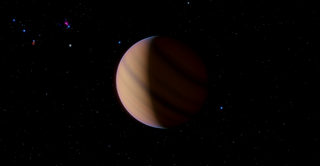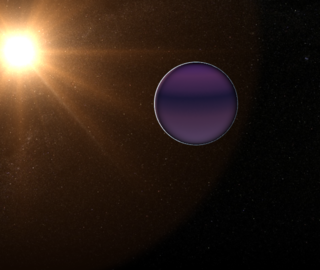Related Research Articles
HD 117618, named Dofida by the IAU, is a single, yellow-hued star in the southern constellation of Centaurus. With an apparent visual magnitude of 7.17, it is too faint to be visible to the naked eyes of a typical observer. The distance to this star, as determined from its annual parallax shift of 26.34±0.60 mas as seen from Earth's orbit, is about 124 light years. It is moving further away with a heliocentric radial velocity of around +1.6 km/s.
HD 208487 is a star with an orbiting exoplanet in the constellation of Grus. Based on parallax measurements, it is located at a distance of 146.5 light years from the Sun. The absolute magnitude of HD 208487 is 4.26, but at that distance the apparent visual magnitude is 7.47, which is too faint to be viewed with the naked eye. The system is drifting further away with a radial velocity of 5.6 km/s. It is a member of the thin disk population.
HD 179949 is a 6th magnitude star in the constellation of Sagittarius. It is a yellow-white dwarf, a type of star hotter and more luminous than the Sun. The star is located about 90 light years from Earth and might be visible under exceptionally good conditions to an experienced observer without technical aid; usually binoculars are needed.
HD 130322 is a star with a close orbiting exoplanet in the constellation of Virgo. The distance to this system is 104 light years, as determined using parallax measurements. It is drifting closer to the Sun with a radial velocity of −12.4 km/s. With an apparent visual magnitude of 8.04, it is too dim to be visible to the naked eye; requiring binoculars or a small telescope to view. Being almost exactly on the celestial equator the star is visible everywhere in the world except for the North Pole. The star shows a high proper motion, traversing the celestial sphere at an angular rate of 0.197 arcsec yr−1.

Pollux b, formally named Thestias, is an exoplanet candidate orbiting the star Pollux approximately 34 light-years away in the constellation of Gemini. It is also designated β Geminorum b or HD 62509 b. If this planet exists, it has a minimum mass of about twice the mass of Jupiter, and it moves around Pollux in 1.61 years at a distance of 1.64 AU in a nearly circular orbit. However, its existence has been disputed.
HD 68988 is a star in the northern constellation of Ursa Major. It has been given the proper name Násti, which means star in the Northern Sami language. The name was selected in the NameExoWorlds campaign by Norway, during the 100th anniversary of the IAU. HD 68988 is too faint to be seen with the naked eye, having an apparent visual magnitude of 8.20. The star is located at a distance of 199 light years from the Sun based on parallax. It is drifting closer with a radial velocity of −69 km/s and is predicted to come as close as 78 light-years in 617,000 years.
HD 8574 is a single star in the equatorial constellation of Pisces. It can be viewed with binoculars or a telescope, but not with the naked eye having a low apparent visual magnitude of +7.12. The distance to this object is 146 light years based on parallax, and it has an absolute magnitude of 3.88. The star is drifting further away from the Sun with a radial velocity of +18 km/s. It has a relatively high proper motion, advancing across the celestial sphere at the rate of 0.298 arc seconds per annum.
HD 4208 b, officially named Xolotlan, is an extrasolar planet discovered by the California and Carnegie Planet Search team using the Keck telescope. The planet is probably somewhat less massive than Jupiter, although only its minimum mass is known. Its orbital distance is 1.67 AU, slightly further than Mars, and its eccentricity is low.
HD 4203 b is an exoplanet more massive than Jupiter. It orbits two times further from the star than Earth to the Sun. The planet takes 1.1824 year to orbit the star very eccentrically from 1.00 AU to 3.14 AU. The planet was discovered by Steve Vogt using the Keck telescope.
HD 224693 b, also named Xólotl, is an extrasolar planet orbiting the star HD 224693 every 27 days with a minimum mass 70% of Jupiter.
HD 99109 b, formally named Perwana, is an extrasolar planet approximately 197 light-years away in the constellation of Leo. The planet was confirmed in 2006 to be orbiting the orange dwarf star HD 99109. The planet is about one half the mass of Jupiter, classifying the planet as a Jovian planet. The orbital eccentricity is about the same as Mars.
HD 117618 b, named Noifasui by the IAU, is an exoplanet discovered orbiting the star HD 117618 in September 2004. The planet is a small gas giant less than a fifth the mass of Jupiter. It orbits close to its star in a very eccentric orbit.

HD 179949 b, formally named Mastika, is an extrasolar planet discovered by the Anglo-Australian Planet Search at the Anglo-Australian Observatory, which orbits the star HD 179949. The planet is a so-called "hot Jupiter", a Jupiter-mass planet orbiting very close to its parent star. In this case, orbital distance is almost one-tenth that of Mercury from the Sun. One orbital revolution lasts only about 3 days.

HD 76700 b is an exoplanet orbiting the G-type main sequence star HD 76700 approximately 198 light years away in the southern constellation Volans. The planet was discovered in 2002, and was announced in 2003.
HD 188015 b is an extrasolar planet announced by the California and Carnegie Planet Search team in 2005. Like majority of known planets, it was discovered using the radial velocity method.
HD 210277 b is an extrasolar planet orbiting the star HD 210277. It was discovered in September 1998 by the California and Carnegie Planet Search team using the highly successful radial velocity method. The planet is at least 24% more massive than Jupiter. The mean distance of the planet from the star is slightly more than Earth's distance from the Sun. However, the orbit is very eccentric, so at periastron this distance is almost halved, and at apastron it is as distant as Mars is from the Sun.
HD 30177 b is an extrasolar planet located approximately 181.6 light-years away in the constellation of Dorado, orbiting the star HD 30177.
HD 208487 b is an extrasolar planet located approximately 144 light-years away in the constellation of Grus, orbiting the star HD 208487. This planet has a minimum mass close to half that of Jupiter and is most probably a gas giant. The planet orbits the star in a close, eccentric orbit. One revolution takes 130 days to complete. This planet was discovered on September 16, 2004 by Tinney, Butler, and Marcy et al. using Doppler spectroscopy to measure the star's radial velocity changing over time as the planet revolves around its orbit.
HD 102117 b, formally named Leklsullun, is a planet that orbits the star HD 102117. The planet is a small gas giant a fifth the size of Jupiter. It orbits very close to its star, but not in a "torch orbit" like the famous 51 Pegasi b. It was one of the smallest extrasolar planets discovered as of 2006.
HD 68988 c is an exoplanet located approximately 192 light-years away in the constellation of Ursa Major, orbiting the star HD 68988. The parameters including period and eccentricity are highly uncertain. The semimajor axis was initially believed to be 5.32 AU with an orbital period of 4100 ± 7300 days. The planetary orbit was significantly refined in 2021.
References
- ↑ Butler, R. P.; et al. (2006). "Catalog of Nearby Exoplanets". The Astrophysical Journal. 646 (1): 505–522. arXiv: astro-ph/0607493 . Bibcode:2006ApJ...646..505B. doi:10.1086/504701. hdl:2299/1103. S2CID 119067572. Archived from the original on 2019-12-07. Retrieved 2009-03-11.
- ↑ Vogt, Steven S.; et al. (2002). "Ten Low-Mass Companions from the Keck Precision Velocity Survey". The Astrophysical Journal. 568 (1): 352–362. arXiv: astro-ph/0110378 . Bibcode:2002ApJ...568..352V. doi:10.1086/338768. S2CID 2272917.
- ↑ "Approved names". NameExoworlds. Archived from the original on 2019-12-19. Retrieved 2020-01-02.
- ↑ "International Astronomical Union | IAU". www.iau.org. Retrieved 2020-01-02.